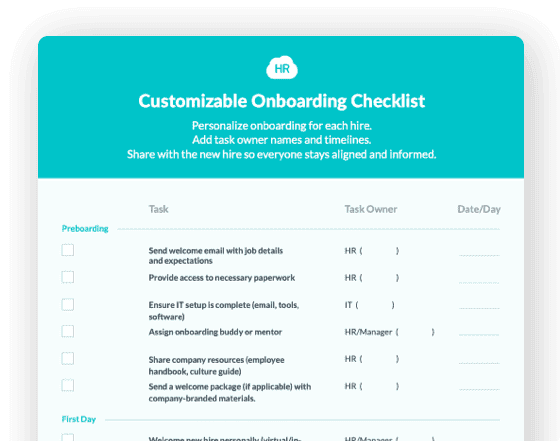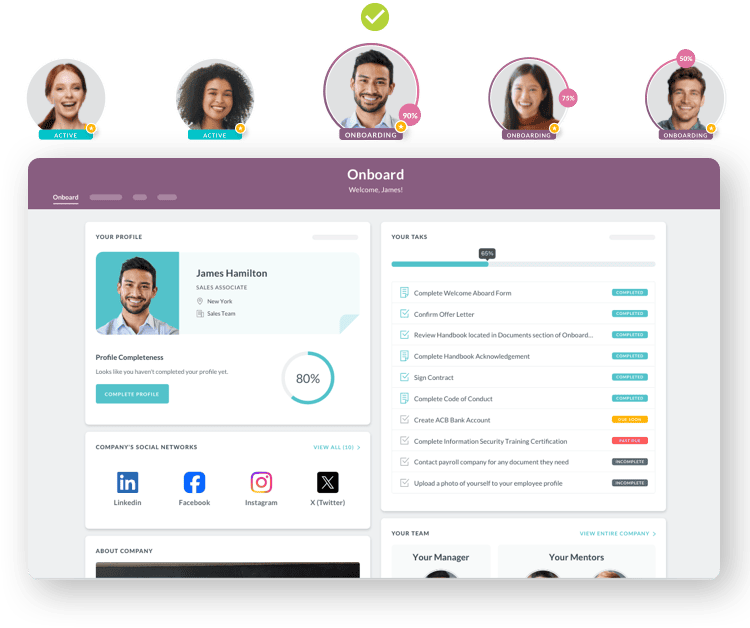Yearly Salary to Hourly
- Why Salary to Hourly Conversion Matters for Your Business
- Essential Elements of Accurate Salary Conversion
- Comparing Salary and Hourly Compensation Structures
- How to Calculate and Implement Accurate Conversions
- Common Mistakes That Create Compliance and Financial Risk
- How Different Industries Apply Salary to Hourly Conversion
- Step by Step Implementation Guide
- The Future of Compensation Structure and Calculation

 Cut onboarding time
by 60%—here's the
Ultimate Checklist
that helped do it.
Cut onboarding time
by 60%—here's the
Ultimate Checklist
that helped do it.

Converting yearly salary to hourly rate is a fundamental calculation that helps business leaders make informed compensation decisions, ensure legal compliance, and communicate total rewards effectively. This conversion translates an annual compensation figure into an equivalent hourly wage, revealing the true cost per working hour and enabling accurate comparisons across different pay structures. Whether evaluating job offers, planning budgets, or reclassifying positions, understanding this conversion protects your organization from compliance violations while supporting transparent compensation practices.
The process involves more than simple division. You must account for actual working hours, overtime regulations, benefits costs, and federal and state labor laws. According to the Fair Labor Standards Act, employers must correctly classify employees as exempt or nonexempt, which directly impacts how compensation calculations work. Misclassification creates serious legal and financial risks, from back pay claims to Department of Labor penalties. Smart businesses use salary to hourly conversions to validate their compensation structure, benchmark against market rates, and ensure every position meets both internal equity standards and external compliance requirements.
Why Salary to Hourly Conversion Matters for Your Business
Understanding salary to hourly conversion gives you strategic advantages beyond basic payroll math. This knowledge helps you make better hiring decisions, manage budgets more accurately, and avoid expensive compliance mistakes that could cost your business thousands in penalties and back wages.
Accurate conversion enables you to compare compensation across different employment types. When evaluating whether a position should be salaried or hourly, you need clear data showing which structure delivers better value while meeting employee expectations. Many organizations discover that converting certain roles from salary to hourly, or vice versa, significantly impacts both retention rates and operational costs. The decision affects everything from overtime expenses to benefits administration and employee satisfaction.
Budget planning requires precise hourly cost calculations. Finance teams need to know actual per hour expenses, including not just base pay but also employer taxes, benefits contributions, and overhead allocations. Converting salaries to hourly rates reveals hidden costs and helps project department budgets with greater accuracy. This visibility becomes particularly valuable when planning staff expansions, calculating project costs, or justifying headcount requests to senior leadership.
Compliance protection starts with correct classification. The FLSA mandates that nonexempt employees receive overtime pay at one and a half times their regular rate for hours beyond 40 in a workweek. According to ADP guidance on exempt versus nonexempt employees, misclassification represents one of the most common and costly HR violations. Converting salary to hourly helps you verify that compensation meets minimum thresholds and that overtime calculations follow legal requirements. This diligence protects your business from audits, lawsuits, and reputational damage.
Essential Elements of Accurate Salary Conversion
Converting yearly salary to hourly rate requires understanding several key factors that affect the final calculation. Each element plays a specific role in ensuring your conversion reflects true compensation costs and meets legal standards.
Standard Working Hours:
Most full time positions assume 2,080 working hours per year, calculated as 40 hours per week multiplied by 52 weeks. This baseline provides the foundation for basic conversion calculations.
Paid Time Off Adjustments:
Actual working hours differ from standard hours when you account for vacation days, holidays, and sick leave. Organizations must decide whether to calculate hourly rates based on scheduled hours or actual working hours.
Overtime Considerations:
For nonexempt employees, the regular hourly rate serves as the basis for overtime calculations at time and a half. This makes accurate conversion critical for payroll accuracy and compliance.
Benefits Valuation:
True hourly cost extends beyond base wage to include employer contributions for health insurance, retirement plans, payroll taxes, and other benefits that significantly impact total compensation.
FLSA Classification:
Whether a position qualifies as exempt or nonexempt under federal law fundamentally changes how you structure and calculate compensation, affecting everything from overtime eligibility to minimum salary thresholds.


State and Local Requirements:
Many jurisdictions impose higher minimum wages, different overtime rules, or additional paid leave mandates that affect conversion calculations and compensation structures.
Comparing Salary and Hourly Compensation Structures
|
Factor |
Salaried (Exempt) Employees |
Hourly (Nonexempt) Employees |
|
Pay Structure |
Fixed annual amount divided across pay periods |
Variable pay based on actual hours worked |
|
Overtime Eligibility |
Not eligible for overtime pay |
Required to receive 1.5x rate for hours over 40 per week |
|
Payment Consistency |
Same amount each pay period |
Fluctuates based on hours worked and overtime |
|
Minimum Threshold |
Must meet FLSA salary minimum ($43,888 annually as of 2024) |
Must receive at least the minimum wage per hour |
|
Time Tracking |
Often not required to track daily hours |
Must record all hours worked for accurate payment |
|
Job Level |
Typically professional, managerial, or administrative roles |
Often operational, technical, or entry-level positions |
|
Budget Predictability |
Highly predictable fixed costs |
Variable costs depending on workload and hours |
How to Calculate and Implement Accurate Conversions
Business leaders need reliable methods for converting between salary and hourly rates. These best practices ensure your calculations meet compliance standards while supporting strategic compensation decisions.
Use the Standard Calculation Formula:
Divide annual salary by 2,080 hours for basic conversion. For example, a $52,000 yearly salary equals $25 per hour ($52,000 divided by 2,080). This straightforward calculation provides the foundation for most salary to hourly conversions and works well for initial comparisons and budget planning.
Account for Actual Working Time:
Adjust calculations for paid time off when determining true hourly costs. If employees receive three weeks of vacation and ten holidays, they work approximately 1,960 hours annually instead of 2,080. Dividing the same $52,000 salary by 1,960 hours yields $26.53 per hour, revealing the actual cost per working hour and providing more accurate budget projections.
Verify FLSA Compliance Requirements:
Check that hourly rates meet or exceed federal and state minimum wages. Review whether positions classified as exempt actually meet the salary threshold and duties tests required by law. According to Department of Labor guidelines, exempt employees must earn at least $43,888 annually (as of 2024) and perform specific types of work. Failing these tests means positions must be reclassified as nonexempt with overtime eligibility.
Calculate Total Compensation Costs:
Add employer taxes, benefits contributions, and other costs to base hourly rates for complete picture. Social Security, Medicare, unemployment insurance, workers compensation, health insurance, and retirement contributions typically add 25 to 40 percent to base wages. A $25 per hour base rate might actually cost your business $31.25 to $35 per hour when you include all employer expenses.
Integrate with Payroll Systems:
Modern payroll integration platforms automate conversion calculations and ensure accuracy across pay periods. These systems track hours, calculate overtime automatically, apply current tax rates, and generate compliant records. Automation reduces errors, saves administrative time, and provides audit trails that protect your business during compliance reviews.
Document Your Methodology:
Create clear written procedures explaining how your organization calculates conversions, what factors you include, and how you ensure compliance. This documentation proves invaluable during audits, supports consistent decision making across departments, and helps train new HR team members on proper calculation methods.
Common Mistakes That Create Compliance and Financial Risk
Even experienced HR professionals make errors when converting salary to hourly rates. Understanding these pitfalls helps you avoid problems that could cost your organization significant money and create legal exposure.
Forgetting Overtime Obligations:
Many businesses incorrectly assume that paying someone a salary automatically exempts them from overtime. The FLSA requires that employees meet both salary level and duties tests to qualify for exemption. Simply calling someone salaried or paying them on a salary basis doesn't eliminate overtime obligations if they don't meet all exemption criteria. This mistake leads to expensive back pay claims and Department of Labor violations.
Using Incorrect Hour Assumptions:
Dividing by the wrong number of hours produces inaccurate results that cascade through budgets and compensation decisions. Some businesses mistakenly use 1,920 hours (based on 40 hour weeks for 48 weeks) or other incorrect figures. Always use 2,080 hours as your standard baseline unless you have specific reasons to adjust for documented paid time off that reduces actual working hours.
Ignoring State Specific Requirements:
Federal law sets minimum standards, but many states impose higher salary thresholds, different overtime rules, or additional requirements that affect conversions. California, New York, and other states have established salary minimums well above federal levels. Businesses with multi state operations must track different requirements for each location and ensure compliance with the most stringent applicable standards.
Overlooking Total Compensation Costs:
Focusing only on base salary while ignoring employer taxes and benefits creates budget shortfalls and underestimates true employment costs. When converting salary to hourly for project costing, billing rates, or budget planning, you must include all employer expenses. Otherwise, you'll consistently underestimate costs and potentially lose money on projects or departments.
Failing to Update Classifications:
Business needs evolve, job duties change, and regulations update regularly. Positions that were correctly classified as exempt five years ago might no longer meet current standards. Regular audits of job classifications, salary levels, and actual duties performed help you catch problems before they become compliance violations or employee grievances.
How Different Industries Apply Salary to Hourly Conversion
Organizations across sectors use salary to hourly conversions differently based on their workforce composition, operational needs, and industry specific challenges. Learning from these applications helps you adapt best practices to your own business context.
Healthcare Organizations Manage Complex Schedules:
Hospitals and medical facilities convert salaries to hourly rates frequently because many clinical staff work variable schedules with night shifts, weekend differentials, and on call requirements. Healthcare HR systems must track multiple pay rates, calculate shift differentials accurately, and ensure compliance with healthcare specific overtime rules. Administrators converting salaried positions to hourly status need to account for certification requirements, continuing education costs, and specialty pay premiums that affect total compensation.
Manufacturing Focuses on Production Costs:
Industrial companies use hourly cost calculations extensively for product pricing, job costing, and efficiency analysis. When a manufacturing firm knows exact hourly labor costs including benefits and overhead, they can price products competitively while maintaining profitability. Many manufacturers convert supervisor salaries to hourly equivalents to compare management costs against production worker expenses and identify opportunities for organizational restructuring.
Professional Services Firms Calculate Billing Rates:
Consulting companies, law firms, and other professional services organizations convert employee salaries to hourly rates to establish client billing rates. A consultant earning $104,000 annually ($50 per hour based on 2,080 hours) might be billed to clients at $150 to $200 per hour. This markup covers overhead, benefits, non billable time, and profit margins while ensuring the business remains financially viable.
Step by Step Implementation Guide
Successfully implementing salary to hourly conversions across your organization requires systematic planning and clear communication. Follow these sequential steps to ensure smooth execution and minimize disruption.
Step 1: Audit Current Classifications:
Begin by reviewing all positions to verify current exempt or nonexempt status is correct. Document each position's duties, salary level, and classification basis. Identify any positions that might be misclassified based on current FLSA standards. This audit provides the foundation for all subsequent conversion work and helps you prioritize which positions need immediate attention.
Step 2: Gather Market Data:
Research comparable positions in your industry and region using salary surveys, government statistics, and compensation benchmarking tools. Understanding market rates helps you set competitive hourly wages when converting positions from salary to hourly status. Market data also validates whether your current salary levels meet legal minimums and industry standards.
Step 3: Calculate Conversion Scenarios:
Run calculations for positions you're considering converting, including base hourly rates, overtime potential, and total compensation costs. Model different scenarios to understand financial implications. Will converting this position to hourly save money or cost more? How will overtime requirements affect total annual costs? What happens if workload increases and overtime becomes necessary?
Step 4: Update Policies and Systems:
Modify compensation policies to reflect new pay structures, update payroll systems to handle conversions correctly, and create clear guidelines for time tracking and overtime approval. Modern HRIS platforms streamline these updates by centralizing employee data, automating calculations, and ensuring consistent application across the organization.
Step 5: Communicate Changes Transparently:
Meet with affected employees individually to explain reasons for conversions, how calculations work, and how changes impact their total compensation. Address concerns about perceived prestige loss or compensation changes. Transparency builds trust and reduces resistance to necessary changes, particularly when converting previously salaried employees to hourly status.
Step 6: Monitor and Adjust:
Track actual costs after implementation, monitor overtime usage, and compare results against projections. Some positions may require rate adjustments or reclassification based on real world experience. Regular monitoring helps you catch problems early and demonstrates to employees that you're committed to fair compensation practices.
The Future of Compensation Structure and Calculation
Compensation practices are evolving rapidly as technology advances, workforce expectations shift, and regulations adapt to modern work arrangements. Understanding these trends helps you prepare your organization for changes ahead while maintaining competitive compensation practices.
Pay transparency legislation is spreading across states and municipalities, requiring employers to disclose salary ranges in job postings and potentially to current employees. This movement makes accurate salary to hourly conversions increasingly important because employees can easily compare their compensation against market rates. Organizations must ensure their conversion methods withstand scrutiny and that their compensation structures reflect defensible, equitable principles.
Artificial intelligence and advanced analytics are transforming how businesses approach compensation planning. Modern platforms analyze vast datasets to recommend optimal pay structures, predict overtime costs, and identify classification risks before they become compliance problems. These tools make complex calculations simple and help even small businesses access sophisticated compensation planning previously available only to large enterprises with dedicated teams.
Remote work has complicated salary to hourly conversions because employees working from different states or countries face different tax implications, minimum wage requirements, and overtime rules. Organizations with distributed workforces need sophisticated systems that handle multi jurisdiction compliance while maintaining internal pay equity. According to recent global PTO compliance research, companies managing international teams face particularly complex challenges balancing local requirements with global compensation philosophies.
Total rewards statements are gaining popularity as organizations recognize that employees often don't fully appreciate their complete compensation packages. These statements convert all components, salaries, bonuses, benefits, and perks, into clear dollar values that employees can understand. Many organizations calculate hourly value of benefits to show employees the true hourly rate they're receiving when you include health insurance, retirement contributions, and other indirect compensation.
Keep Reading
From Manual to Automated: A Complete Guide to Digitizing Employee Onboarding for Large Organizations
Sarah Chen, Director of HR at a 7,000-employee healthcare organization, starts her Monday
Enterprise HR Software in 2025: Why Traditional Enterprise Platforms Fall Short and What Actually Works
Traditional enterprise human resources software systems promise comprehensive solutions
AI in Onboarding: Complete Guide for 2026
You’ve probably been hearing this multiple times a day — AI is transforming HR. But
Ready to streamline your onboarding process?
Book a demo today and see how HR Cloud can help you create an exceptional experience for your new employees.







